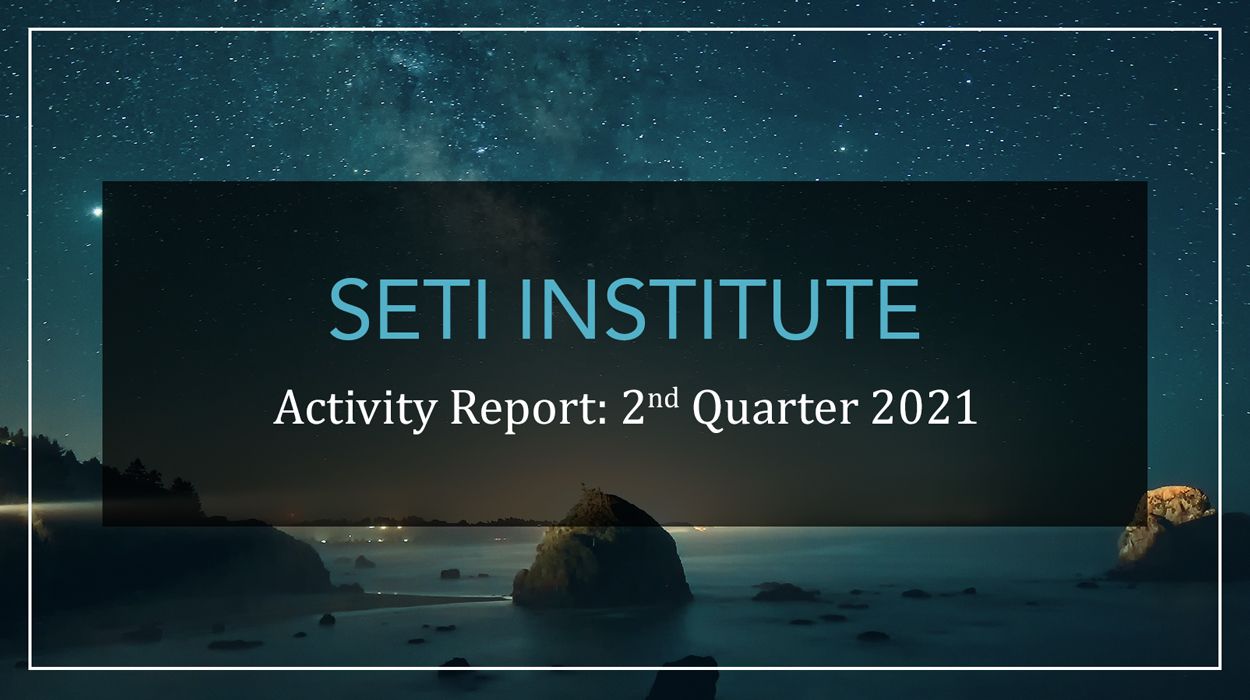
The SETI Institute is leading humanity’s quest to understand the origins and prevalence of life and intelligence in the universe and share our knowledge with the world. Our more than 100 scientists have been incredibly productive, publishing their research in peer-reviewed journals, presenting their learning at scientific conferences, supporting missions and conducting field research. All this even as COVID restrictions continue to limit access to some labs and field sites, force the cancellation of events including conferences and challenge us all to find new ways to study and explore, collaborate and share. We are proud of the groundbreaking work that continues at our Carl Sagan Center for Research, as well as programming at our Center for Education and our Center for Outreach.
57 peer-reviewed articles including:
- Smith, J. C.; Morris, R. L.; Rumpf, C.; Longenbaugh, R.; McCurdy, N.; Henze, C.; Dotson, J. (2021). An automated bolide detection pipeline for GOES GLM, Icarus, 368, 114576.
- Jenniskens, P.; Lauretta, D. S.; Towner, M. O.; Heathcote, S.; Jehin, J.; et al. (2021). Meteor showers from long-period comets, Icarus, 365, article id.114469.
- Farah, W., Pollak, A. W., Siemion, A. P. V., Antonio, F., Schoultz, S., Hickish, J., et. al. (2021). A bright double-peaked radio burst from FRB20201124A detected with the Allen Telescope Array, The Astronomer's Telegram, 14676, 1.
- Ertem, G. (2021). The Role of Minerals in the Events Leading to the Origin of Life, Astrobiology, 21, 137-150.
- Cartwright, R.J.; Beddingfield, C.B.; Roser, J.E.; Showalter, M.R.; et al. (2021). The Science case for spacecraft exploration of the Uranian satellites: Candidate ocean worlds in an ice giant system, Planetary Science Journal, 2, 120.
Conference abstracts and proceedings:
- Bishop, J. L.; Schiffman, P.; Gruendler, L.; Murad, E.; Dyar, M. D.; et al. (2021). Sulfate-opal-phyllosilicate assemblages at Kilauea caldera as an analog for surface alteration on Mars. Workshop on Terrestrial Analogs for Planetary Exploration, Abstract #8055.
- Jin, M.; Loyd, P.; Boro Saikia, S.; Lueftinger, T. Global MHD Modeling of Epsilon Eridani’s Stellar Winds and CMEs, Stars and Planets in the Ultraviolet Symposium, May 3-5, 2021, Virtual.
- White O. L. et al. (2021). A Global Geological Map of Pluto at 1:7M Scale, 2021 Annual Meeting of Planetary Geologic Mappers, June 14-15, Abstract #7009.
Technical reports and data releases:
- French, R. G.; McGhee-French, C. A.; Gordon, M. K. (2020). Earth-based Uranus Stellar Occultations User Guide.
- Jin, M. (2021). SDO Machine Learning Dataset V2 on SpaceML.
Missions:
- Bishop, J. L. Compact Reconnaissance Imaging Spectrometer for Mars (CRISM), a Visible/near-infrared (VNIR) hyperspectral imager on the Mars Reconnaissance Orbiter (MRO). Work includes mapping rock composition and characterizing aqueous alteration on the surface that constrain the history of water and geochemical processes on Mars. 2002-ongoing.
- Kagawa H BioNutrients-1 Project, ongoing 2019-2024. Sample return from the International Space Station every ~6 months.
- Rosner, S. W. Support of SOFIA Science Instrument Development team, ongoing.
- Sarrazin, P. C. Mars Science Laboratory Science Team member, CheMin Instrument, ongoing.
- Sobron, P. NASA Mars 2020 rover mission Science Team member, SHERLOC and SuperCam instrument development and operation, ongoing.
Highlights:
- Doyle, L. Three-week expedition to Southeast Alaska involving 12 investigators.
- Fenton, L. Fieldwork at Smith Creek Valley, NV, USA, June 4-22, 2021. Purpose: to study the environmental controls on dust devil formation, morphology, and behavior.
- Harman, P. K. Girl Scout Astronomy Club Training, June 27-30, 2021.
VIEW FULL ACTIVITY REPORT HERE.





